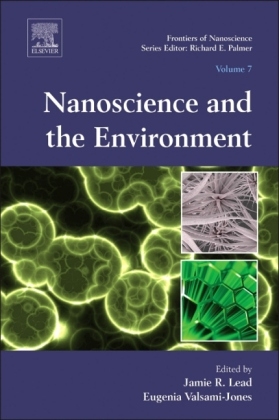
Nanoscience and the Environment
Elsevier / The Lancet (Verlag)
978-0-08-099408-6 (ISBN)
The fast-moving nature of the field and the quality of the submissions make this book essential reading for all those working in this area. It is suitable for researchers from Masters-level upwards, and for regulators and industry. The book can also be used as a high-level teaching aid.
Jamie R. Lead is Director of the SmartState Center for Environmental Nanoscience and Risk (CENR) at the University of South Carolina. He received his PhD in Environmental Chemistry at Lancaster University, UK in 1994, and subsequently undertook postdoctoral work in the UK and Switzerland. He was appointed as Lecturer in Aquatic Chemistry at the University of Birmingham in 2000, becoming Professor of Environmental Nanoscience in 2008 and starting the Facility for Environmental Nanoscience Analysis and Characterization (FENAC) in the same year. Professor Lead retains an adjunct position at the University of Birmingham, UK, after moving to the University of South Carolina, USA, in 2012 to become the Carolina SmartState endowed Professor of Environmental Nanoscience and Risk and founding Director of the CENR. The CENR aims to investigate both the potential environmental and human health implications of manufactured nanomaterials and natural nanomaterials and the sustainable development of nanomaterials for applications to environmental problems. Further information on the CENR can be found at www.cenr.sc.edu. Professor Lead is a Fellow of the Royal Society of Chemistry, the Institute of Nanotechnology and the International Union of Pure and Applied Chemistry and is editor of the journal Environmental Chemistry. He has published more than 120 peer-reviewed papers and has edited 3 books related to natural and manufactured nanomaterials. Eugenia (Éva) Valsami-Jones is a Professor of Environmental Nanoscience at the University of Birmingham. She holds a degree in Earth Sciences from the University of Athens and a PhD in Geochemistry from the University of Newcastle-upon-Tyne. Her research focuses on nanoscale processes in the environment and within biota. She has pioneered the development of traceable stable-isotope labelled nanomaterials and has been working on the development of analytical solutions for the improvement in speed and quality of nanoscale characterisation. Her current research priorities revolve around the application of nanotechnologies in solving environmental problems, particularly related to clean water and sustainable agriculture. She was the Mineralogical Society’s Distinguished Lecturer for 2015 and the Distinguished Guest Lecturer and Medalist of the Royal Society of Chemistry for 2015. She is currently a Royal Society Wolfson Fellow. She is a member of the coordination team of the European Commission’s Nanosafety Cluster.
1. Nanomaterials and the environment M Baalousha, W. How, J. R. Lead, and E. Valsami-Jones 2. Transformations of nanomaterials in the environment S.M. Louie, R. Ma and G. Lowry 3. Environmental fate and exposure modeling of nanomaterials M. Scheringer, A. Praetorius and E.S. Goldberg 4. Macromolecular coronas; importance in nanotoxicology and nanoecotoxicology I. Lynch, E. Valsami-Jones, J. R. Lead, K Dawson 5. Bioavailability and bioaccumulation of metal-based engineered nanomaterials in aquatic environments: Concepts and processes S. Luoma, F.R. Kahn and M-N. Croteau 6. Mechanisms of nanotoxicity K. Schirmer
| Reihe/Serie | Frontiers of Nanoscience |
|---|---|
| Verlagsort | London |
| Sprache | englisch |
| Maße | 152 x 229 mm |
| Gewicht | 420 g |
| Themenwelt | Technik ► Maschinenbau |
| ISBN-10 | 0-08-099408-3 / 0080994083 |
| ISBN-13 | 978-0-08-099408-6 / 9780080994086 |
| Zustand | Neuware |
| Haben Sie eine Frage zum Produkt? |
aus dem Bereich


